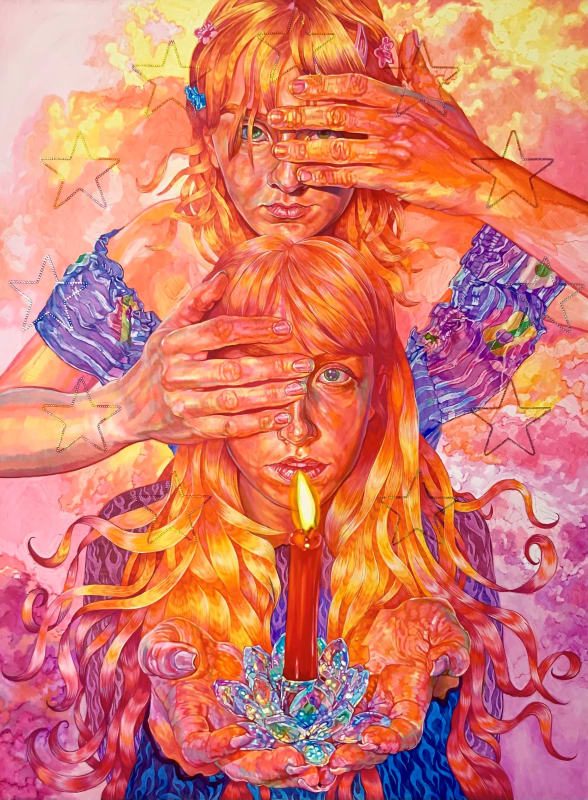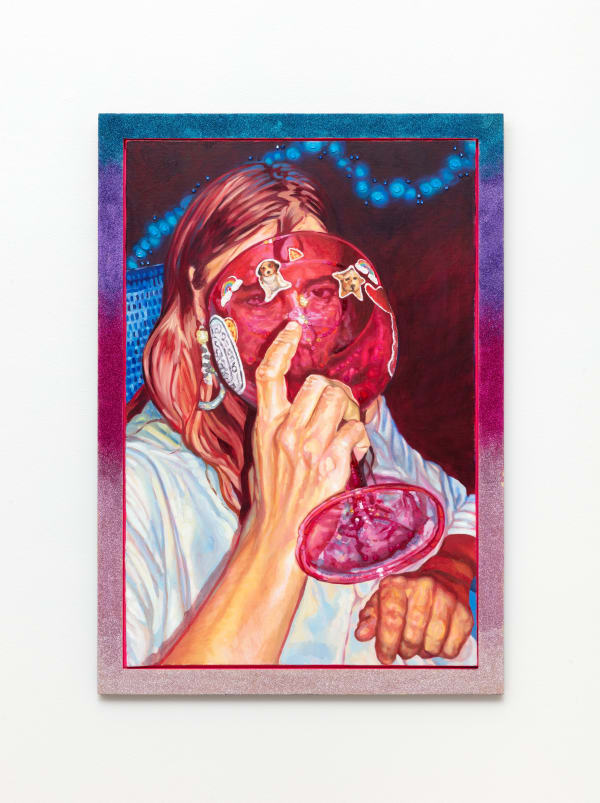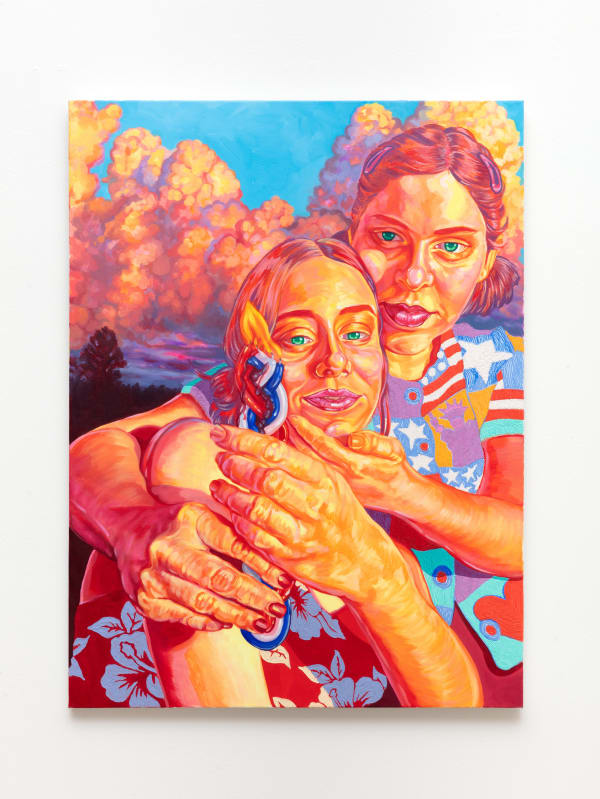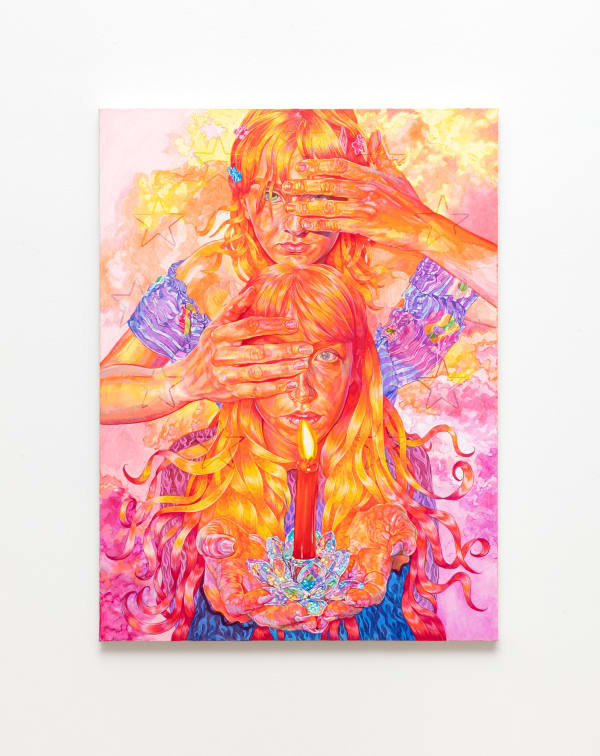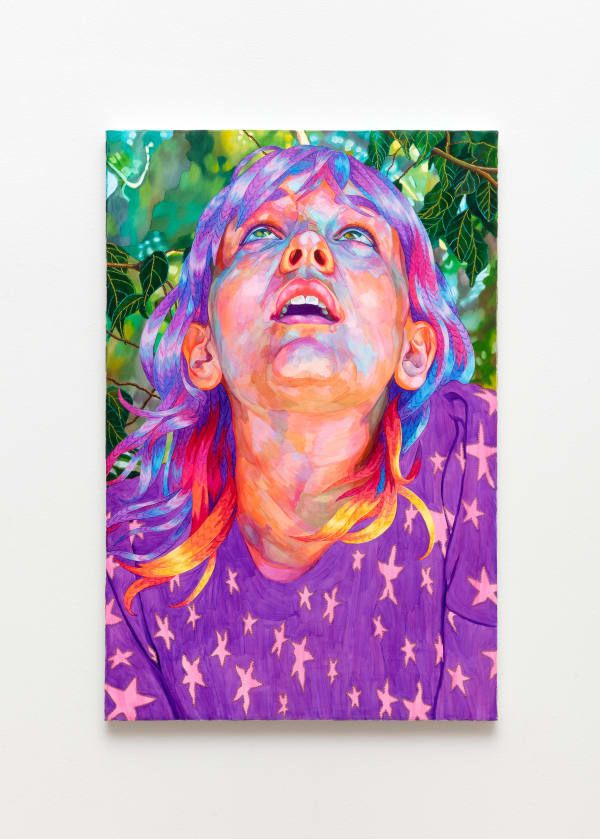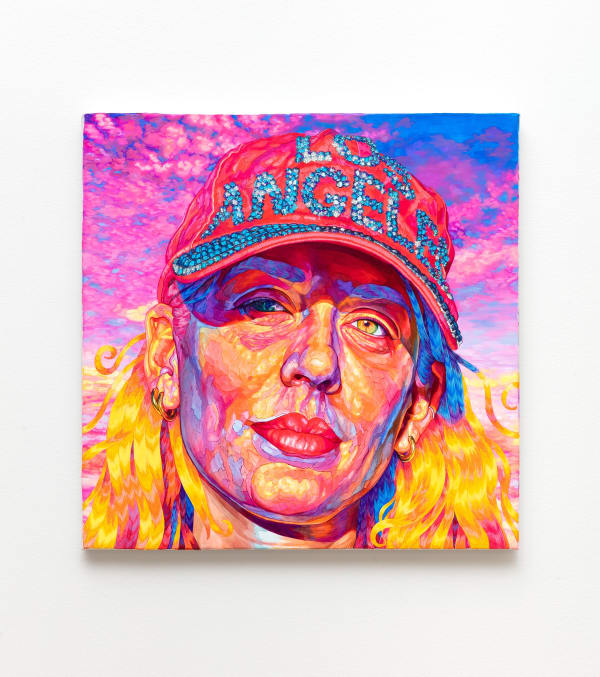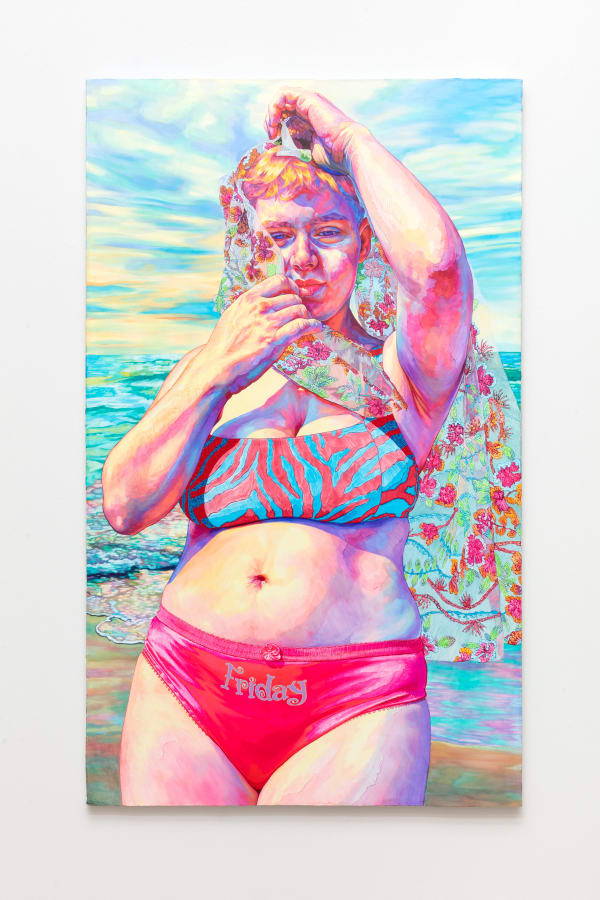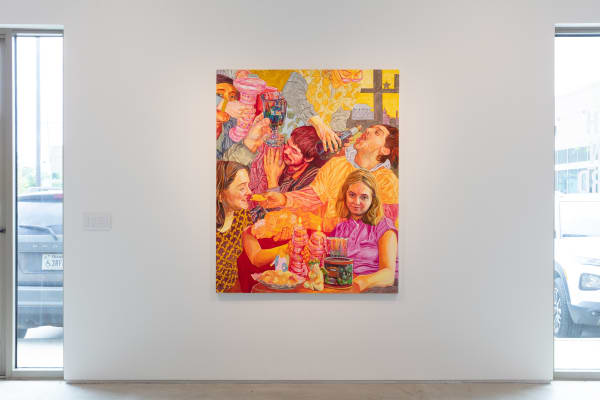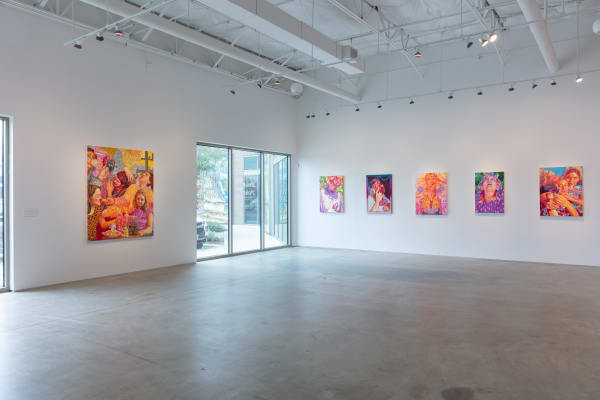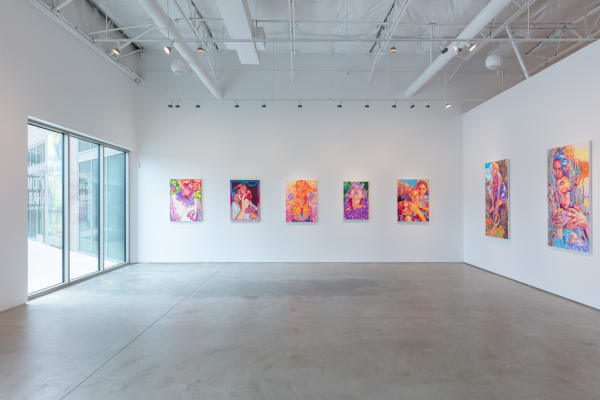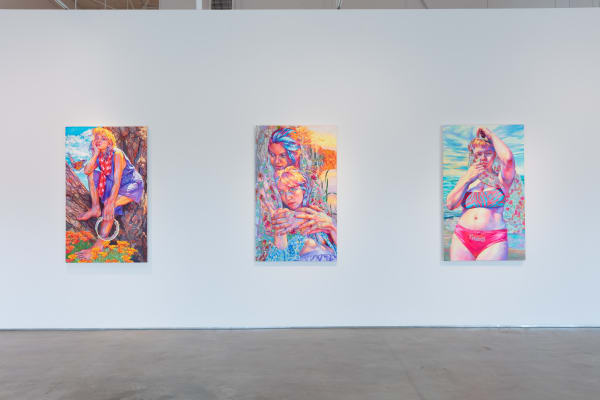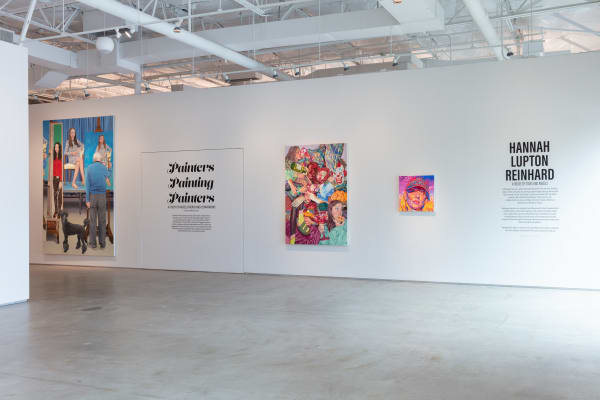Hannah Lupton Reinhard: A House of Stars and Angels
"A Lupton Reinhard painting is like a celebration, to which we are all warmly invited."
When Hannah Lupton Reinhard was studying at the Rhode Island School of Design, there was a secret room called ‘The Crystal Palace’. Swarovski had donated half a million dollars worth of crystals to the school’s furniture department, and Lupton Reinhard, who was on the painting course, had discovered this by chance. In order to enter the room and fill her tote bag with as many Swarovski crystals as possible, she’d tell the story of her grandmother, who began making and selling Swarovski jewelry to Saks Fifth Avenue in the late 80s. As a little girl, Lupton Reinhard spent hours obsessing over her grandmother’s great crystal collection, and this ‘shameless, child-like desire for sparkles’ remains today. The crystals taken from The Crystal Palace, and those bought more recently from wholesale dealers in the Los Angeles Fashion District, finish almost every Lupton Reinhard painting in the original style she now refers to as ‘fantasy realism’.
But the selection of paintings in ‘A House of Stars and Angels’ explore conflicting themes that go beyond the real and unreal, for Lupton Reinhard’s interests also lie within the realms of high and low art, tradition and humor, beauty and ugliness. Her crystals deface the qualities of oil paints revered by art history for so long, her hyper-feminine palette lightens the severity of religion, and the flattery of her subjects isn’t prioritized. A Lupton Reinhard painting is expressive, surprising and meticulous. ‘Everything is important, everything is going to get attention,’ whether it be a female body, a tree trunk or a blade of grass — ‘in each brushstroke is an energy that will always exist.’ Lupton Reinhard’s bold marks and sense of movement and light are influenced by the techniques mastered by the Impressionists of 19th century Paris. Hair flowing in the wind is mimicked rather than copied, life is given to those fleeting, in-between moments shared between people, and all scenes are lit by the magical Californian light that struck Lupton Reinhard when she moved back home to Los Angeles at the start of the pandemic.
Beneath this light is love. Not a romantic love, but a love Lupton Reinhard has for her friends, family and Judaism. The move from the East Coast to the West changed the way she painted. Her paintings became more intimate, more personal, her sisters and closest friends became the main subject and she was compelled to look deeper into what truly meant most to her. Lupton Reinhard uses Judaism, a vital part of her ‘past, present and future,’ as the foundation of the stories she wishes to share to the world. The generosity of Jewish rituals unites not only her sitters but also the viewer, and we needn’t have any knowledge nor understanding of the religion to feel connected. The love is universal.
A Lupton Reinhard painting is like a celebration, to which we are all warmly invited.
Essay By Sabrina Conroy-Iglesias
-
 Hannah Lupton ReinhardSelma, 2019Oil on canvas, framed in glitter on wood39 3/4 x 28 inches
Hannah Lupton ReinhardSelma, 2019Oil on canvas, framed in glitter on wood39 3/4 x 28 inches -
 Hannah Lupton ReinhardThe Last Sunset, 2020Oil on Canvas66 x 54 inches
Hannah Lupton ReinhardThe Last Sunset, 2020Oil on Canvas66 x 54 inches -
 Hannah Lupton ReinhardBefore the Third Star Appears, 2020Oil on Canvas40 x 30 inches
Hannah Lupton ReinhardBefore the Third Star Appears, 2020Oil on Canvas40 x 30 inches -
 Hannah Lupton ReinhardHouse of Stars and Angels, 2020Oil and Swarovski crystals on canvas40 x 30 inches
Hannah Lupton ReinhardHouse of Stars and Angels, 2020Oil and Swarovski crystals on canvas40 x 30 inches
-
 Hannah Lupton ReinhardFriday Night, 2020Oil and Swarovski crystals on canvas72 x 48 inches
Hannah Lupton ReinhardFriday Night, 2020Oil and Swarovski crystals on canvas72 x 48 inches -
 Hannah Lupton ReinhardAre You There?, 2021Oil and Swarovski crystals on canvas36 x 24 inches
Hannah Lupton ReinhardAre You There?, 2021Oil and Swarovski crystals on canvas36 x 24 inches -
 Hannah Lupton ReinhardMiriam's Breath and a Visiting Soul, 2022Oil and Swarovski crystals on canvas60 x 36 inches
Hannah Lupton ReinhardMiriam's Breath and a Visiting Soul, 2022Oil and Swarovski crystals on canvas60 x 36 inches -
 Hannah Lupton ReinhardJewish American Princess, 2022Oil and Swarovski crystals on canvas24 x 24 inches
Hannah Lupton ReinhardJewish American Princess, 2022Oil and Swarovski crystals on canvas24 x 24 inches
-

Installation view, Hannah Lupton Reinhard: A House of Stars and Angels, 2022. Todora Photography.
-

Installation view, Hannah Lupton Reinhard: A House of Stars and Angels, 2022. Todora Photography.
-

Installation view, Hannah Lupton Reinhard: A House of Stars and Angels, 2022. Todora Photography.
-

Installation view, Hannah Lupton Reinhard: A House of Stars and Angels, 2022. Todora Photography.
-

Installation view, Hannah Lupton Reinhard: A House of Stars and Angels, 2022. Todora Photography.
-

Installation view, Hannah Lupton Reinhard: A House of Stars and Angels, 2022. Todora Photography.
-

Installation view, Hannah Lupton Reinhard: A House of Stars and Angels, 2022. Todora Photography.
-

Installation view, Hannah Lupton Reinhard: A House of Stars and Angels, 2022. Todora Photography.
